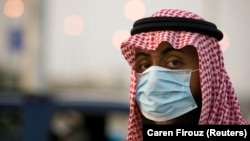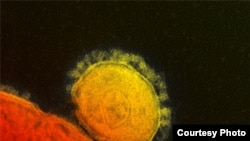This week marks the beginning of Ramadan, the month of Islamic fasting and the time when thousands of Muslims from around the world converge in Saudi Arabia for the Umrah, the lesser pilgrimage, in Mecca and Medina.
Though not as popular as the Hajj pilgrimage in November, the Umrah does present Saudi authorities with crowd control problems, and this year with another worry: Middle East Respiratory Syndrome Coronovirus, or MERS-CoV. Already this year the illness has claimed 38 lives in Saudi Arabia alone out of a total of 65 cases, according the World Health Organization.
This isn’t the first time Saudi authorities have had to deal with viral outbreaks during the pilgrimage season. In 2003, the Kingdom had an outbreak of SARS virus, and in 2009, the H1N1 virus, commonly known as swine flu.
Pilgrims visiting Saudi Arabia in 2009 were given flu masks and hand sanitizers. This year, the government reduced the number of visas it issued and put out a series of announcements advising Muslims to postpone their visit until next year.
Saudi Arabia’s Ministry of Health has set up a medical surveillance system at every entry point into the country, where visitors are being screened for symptoms. International health experts have not advised pilgrims to cancel their travel plans because of the virus, but are urging travelers to take common-sense precautions.
Health precautions
Dr. Lisa D. Rotz is associate director in the Division for Global Health and Migration at the U.S. Centers for Disease Control, or CDC.
“So for example, if you wash your hands often with soap and water or use some of the alcohol-based hand sanitizers, that helps protect you against some of the respiratory illnesses,” Rotz said. “Also, in deference to other travelers, covering your nose and mouth with a tissue when you cough or sneeze, and getting rid of that tissue in a trash can is very important to protect others.”
Rotz said the CDC also advises travelers to avoid touching their nose or mouth with unwashed hands, so that they don’t self-infect, and to avoid close contact with others who are sick, such as sharing cups or eating utensils. Finally, Rotz said, “disinfecting and cleaning touched surfaces such as children’s toys or doorknobs frequently would be another way to protect against illness.”
But are these precautions enough?
Gaps in knowledge
International health authorities say they are still not sure where the MERS-CoV virus originated or exactly how it is transmitted. Dr. Keiji Fukuda, head of World Health Organization health security, outlined what WHO knows—and doesn’t know—about the virus to date.
“We are seeing that there are two main patterns, or two main ways in which people are getting infected,” Fukuda said. “The first is that in communities, that is, in towns and so on, there are sporadic infections occurring in people.”
But Fukuda said “one of the key pieces of missing information is whether there are many people who have mild infections or asymptomatic infections that we are missing,” he said. “Because we have gaps in that kind of information, it makes it very hard to peer into the future and make any predictions.”
Fukuda said there are three possible future scenarios: The virus could stabilize at the current rate of about 20 a month, fade out on its own or explode into a major outbreak.
To be on the safe side, the WHO this week convened an emergency committee of international disease experts, including epidemiologists, virologists and public health doctors, to pool together information and decide how to respond should the virus become epidemic. And the Saudi Arabia Ministry of Health has set up a webpage with updates and advice on protecting against the MERS-CoV.
Here in the United States, Rotz said the CDC will be working with airport authorities and state public health officials to recognize and provide health care to any travelers returning ill from areas where the virus has been identified.
Though not as popular as the Hajj pilgrimage in November, the Umrah does present Saudi authorities with crowd control problems, and this year with another worry: Middle East Respiratory Syndrome Coronovirus, or MERS-CoV. Already this year the illness has claimed 38 lives in Saudi Arabia alone out of a total of 65 cases, according the World Health Organization.
This isn’t the first time Saudi authorities have had to deal with viral outbreaks during the pilgrimage season. In 2003, the Kingdom had an outbreak of SARS virus, and in 2009, the H1N1 virus, commonly known as swine flu.
Pilgrims visiting Saudi Arabia in 2009 were given flu masks and hand sanitizers. This year, the government reduced the number of visas it issued and put out a series of announcements advising Muslims to postpone their visit until next year.
Saudi Arabia’s Ministry of Health has set up a medical surveillance system at every entry point into the country, where visitors are being screened for symptoms. International health experts have not advised pilgrims to cancel their travel plans because of the virus, but are urging travelers to take common-sense precautions.
Health precautions
Dr. Lisa D. Rotz is associate director in the Division for Global Health and Migration at the U.S. Centers for Disease Control, or CDC.
“So for example, if you wash your hands often with soap and water or use some of the alcohol-based hand sanitizers, that helps protect you against some of the respiratory illnesses,” Rotz said. “Also, in deference to other travelers, covering your nose and mouth with a tissue when you cough or sneeze, and getting rid of that tissue in a trash can is very important to protect others.”
Rotz said the CDC also advises travelers to avoid touching their nose or mouth with unwashed hands, so that they don’t self-infect, and to avoid close contact with others who are sick, such as sharing cups or eating utensils. Finally, Rotz said, “disinfecting and cleaning touched surfaces such as children’s toys or doorknobs frequently would be another way to protect against illness.”
But are these precautions enough?
Gaps in knowledge
International health authorities say they are still not sure where the MERS-CoV virus originated or exactly how it is transmitted. Dr. Keiji Fukuda, head of World Health Organization health security, outlined what WHO knows—and doesn’t know—about the virus to date.
“We are seeing that there are two main patterns, or two main ways in which people are getting infected,” Fukuda said. “The first is that in communities, that is, in towns and so on, there are sporadic infections occurring in people.”
But Fukuda said “one of the key pieces of missing information is whether there are many people who have mild infections or asymptomatic infections that we are missing,” he said. “Because we have gaps in that kind of information, it makes it very hard to peer into the future and make any predictions.”
Fukuda said there are three possible future scenarios: The virus could stabilize at the current rate of about 20 a month, fade out on its own or explode into a major outbreak.
To be on the safe side, the WHO this week convened an emergency committee of international disease experts, including epidemiologists, virologists and public health doctors, to pool together information and decide how to respond should the virus become epidemic. And the Saudi Arabia Ministry of Health has set up a webpage with updates and advice on protecting against the MERS-CoV.
Here in the United States, Rotz said the CDC will be working with airport authorities and state public health officials to recognize and provide health care to any travelers returning ill from areas where the virus has been identified.








